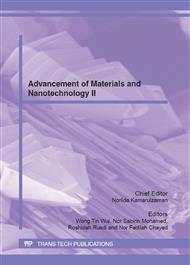p.308
p.312
p.317
p.321
p.325
p.330
p.335
p.342
p.348
Physical Performance of Bamboo Strips-Oil Palm Trunk Veneers Composite Lumber at Different Layer Orientations and Hot Pressing Times
Abstract:
In this study, composite lumber from a combination of bamboo strips and oil palm trunk veneers was produced and physically tested. The bamboo strips and oil palm trunk veneers were laid-up together alternately with two different types of layer orientation, such as parallel and cross orientations to each other. The composite lumber was pressed using hydraulic hot pressing machine at two different pressing times, such as 12 and 15 minutes. Phenol formaldehyde (PF) adhesive was used in the lamination process. Physical performance tests such as cold water delamination (CWD), hot water delamination (HWD), flexural and compression were conducted based on Japanese Agricultural Standard for LVL JAS: SE-10 [1]. Results showed that longer pressing time has increased the physical performance, except for flexural and compression performance of parallel orientation composite lumber. Cross orientation has increased the bonding strength behaviour between bamboo strips and oil palm trunk veneers, thus influenced the low delamination percentage and good modulus of elasticity value of composite lumber. Generally, this study has increased the understanding on physical performance of bamboo strips-oil palm trunk veneers composite lumber at different layer orientations and hot pressing times.
Info:
Periodical:
Pages:
325-329
Citation:
Online since:
July 2012
Price:
Сopyright:
© 2012 Trans Tech Publications Ltd. All Rights Reserved
Share:
Citation:


